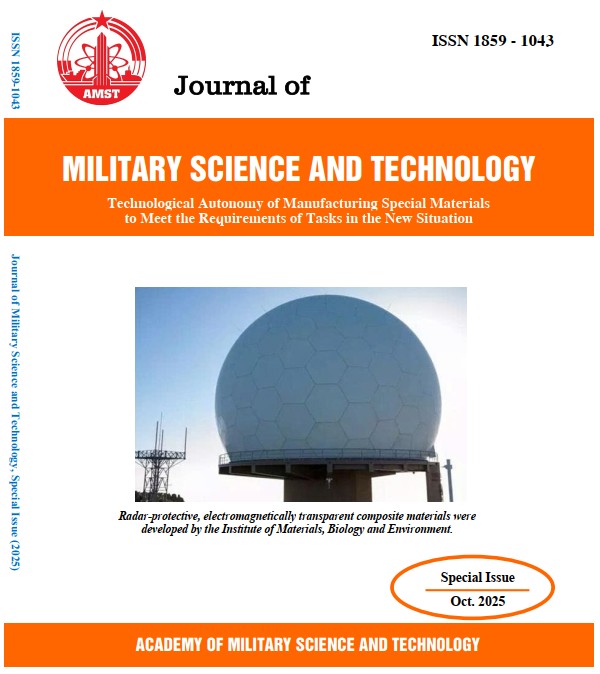Tổng hợp hạt gel trên cơ sở pectin tách chiết từ cây thanh long và nghiên cứu ảnh hưởng của tính chất gel đến khả năng hấp phụ methyl orange
DOI:
https://doi.org/10.54939/1859-1043.j.mst.IMBE.2025.172-178Từ khóa:
Pectin; Polysaccharide; Thân cây thanh long; Hấp phụ; Methyl orange.Tóm tắt
Trong nghiên cứu này, hạt gel tổng hợp từ polysaccharide (PS) chiết xuất từ thân cây thanh long được sử dụng làm chất hấp phụ để loại bỏ thuốc nhuộm Methyl Orange (MO) khỏi dung dịch nước. Các đặc tính hóa lý của PS được đặc trưng bằng kính hiển vi điện tử quét (SEM), phổ hồng ngoại biến đổi Fourier (FTIR) và phân tích diện tích bề mặt theo phương pháp Brunauer–Emmett–Teller (BET). Ảnh hưởng của nồng độ polymer, tỷ lệ pectin-alginate, hàm lượng chất độn và thời gian tạo gel đến hiệu suất tạo gel đã được đánh giá một cách có hệ thống. Quá trình tạo gel tối ưu đạt được ở nồng độ polymer 3%w/v, tỷ lệ pectin–alginate 1:1, hàm lượng chất độn 60%w/v và thời gian tạo gel 60 phút. Trong điều kiện này, các hạt PS thể hiện hiệu suất hấp phụ vượt trội, đạt hiệu quả loại bỏ MO 88,95% sau 120 phút. Những kết quả này cho thấy tiềm năng đáng kể của polysaccharide có nguồn gốc từ cây thanh long trong chế tạo vật liệu hấp phụ dạng gel ứng dụng cho xử lý nước thải chứa thuốc nhuộm.
Tài liệu tham khảo
[1]. J. Kim et al., “Functionalization of pine sawdust biochars with Mg/Al layered double hydroxides to enhance adsorption capacity of synthetic azo dyes: Adsorption mechanisms and reusability”, Heliyon, Vol. 9, No. 3, pp. e14142, (2023).
[2]. N. X. Loc et al., “Chitosan-Modified Biochar and Unmodified Biochar for Methyl Orange: Adsorption Characteristics and Mechanism Exploration”, Toxics, Vol. 10, No. 9, pp. 500, (2022).
[3]. M.-C. Stanciu et al., “Natural Polysaccharide-Based Hydrogels Used for Dye Removal”, Heliyon, Vol. 10, No. 4, pp. 243, (2024).
[4]. G. Annadurai et al., “Use of cellulose-based wastes for adsorption of dyes from aqueous solutions”, Journal of Hazardous Materials, Vol. 92, No. 3, pp. 263–274, (2002).
[5]. M. V. Subbaiah et al., “Carboxylate-functionalized dragon fruit peel powder as an effective adsorbent for the removal of Rhodamine B (cationic dye) from aqueous solution: adsorption behavior and mechanism”, International Journal of Phytoremediation, Vol. 25, No. 2, pp. 146–160, (2023).
[6]. R. D. Chrisnandari et al., “Utilization of Activated Carbon Derived from Dragon Fruit Foliage Using Strong Acid Activator as a Lead (Pb) Metal Adsorbent”, Reka Buana: Jurnal Ilmiah Teknik Sipil dan Teknik Kimia, Vol. 7, No. 2, pp. 141–158, (2022).
[7]. T. P. Chien et al., “Characteristics of pectin extracted from dragon fruit stems in Binh Thuan, Vietnam and gel formation method”, Journal of Military Science and Technology, pp. 268–273, (2024).
[8]. J. Park et al., “Effect of Polymer Solution Concentration on the Swelling and Mechanical Properties of Glycol Chitosan Superporous Hydrogels”, Journal of Applied Polymer Science, Vol. 115, No. 6, pp. 3434–3441, (2010).
[9]. L. Chan et al., “Crosslinking mechanisms of calcium and zinc production of alginate microspheres”, International Journal of Pharmaceutics, Vol. 242, No. 1–2, pp. 255–258, (2002).
[10]. P. Kiaei Pour et al., “Potential effects of alginate-pectin biocomposite on the release of folic acid and their physicochemical characteristics”, J Food Sci Technol, Vol. 57, No. 9, pp. 3363–3370, (2020).
[11]. F. Wang et al., “Structural Analysis and Study of Gel Properties of Thermally-Induced Soybean Isolate-Potato Protein Gel System”, Foods, Vol. 11, No. 22, pp. 3562, (2022).
[12]. F. Olawuyi et al., “Enzymatic Hydrolysis Modifies Emulsifying Properties of Okra Pectin”, Foods, Vol. 11, No. 10, pp. 1497, (2022).
[13]. H. Cheng et al., “Adsorption performance and mechanism of iron-loaded biochar to methyl orange in the presence of Cr6+ from dye wastewater”, Journal of Hazardous Materials, Vol. 415, pp. 125749, (2021).
[14]. D. Dai et al., “Investigation of the dislocation of natural fibers by Fourier-transform infrared spectroscopy”, Vibrational Spectroscopy, Vol. 55, No. 2, pp. 300–306, (2011).
[15]. S. de Bruin et al., “FT-IR micro-spectroscopy for imaging the extracellular matrix composition in biofilms”, bioRxiv, pp. 2024–2008, (2024).
[16]. Chen et al., “Enhanced Adsorption of Methyl Orange from Aqueous Phase Using Chitosan–Palmer Amaranth Biochar Composite Microspheres”, Molecules, Vol. 29, No. 8, pp. 1836, (2024).
[17]. Guo et al., “Synergistic effect of hydrogen bonding and π-π interaction for enhanced adsorption of rhodamine B from water using corn straw biochar”, Environmental Pollution, pp. 121060, (2023).







